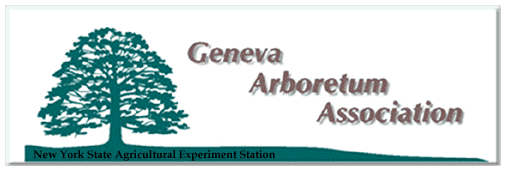

Perhaps you have noticed the massive multicolored trees which dominate the Hedrick Hall south lawn. Would you guess that they might be perhaps 60 years old or less? They are two extremely fine specimens of Platanus occidentalis, the Eastern sycamore, also known as buttonwood, buttonball or planetree. P. occidentalis is one of the largest native American deciduous trees (150 ft ht, 80 ft spread, 11.5 ft trunk diameter). It grows rapidly: first-year seedlings have been documented to reach 8 feet.
 Sycamore's
prime habitat is found in the Ohio and Mississippi river valleys but it
ranges from Maine to Ontario to Minnesota, south to Florida and Texas. P.
occidentalis is a very striking tree, easily recognized at a distance
due to its mottled bark and open spreading crown. The sycamore sheds its
bark - called exfoliation - annually like a snake sheds its skin.
The older red-gray bark flakes off in jigsaw puzzle-shaped plates exposing
the green-to-cream inner bark.
Sycamore's
prime habitat is found in the Ohio and Mississippi river valleys but it
ranges from Maine to Ontario to Minnesota, south to Florida and Texas. P.
occidentalis is a very striking tree, easily recognized at a distance
due to its mottled bark and open spreading crown. The sycamore sheds its
bark - called exfoliation - annually like a snake sheds its skin.
The older red-gray bark flakes off in jigsaw puzzle-shaped plates exposing
the green-to-cream inner bark.
Buttonwood or buttonball tree has been given these two common names because it produces "button ball" fruit clusters; the seeds are tightly packed into large round fruits or "balls," which hang near the tips of branchlets. Platanaceae is a monotypic family (one member) with one genus Platanus, having 10 closely related species; three native to the United States, four in Mexico, and three in southeastern Europe and southwestern Asia. Eastern sycamore is one of the most common stream, riverbank, bottom-land and flood-plain species. In the U.S., sycamore has two cousins, the Arizona (P. wrightii) and California (P. racemosa) sycamores, which grow in similar wet areas in these two western states.
You may also be familiar with the London planetree (Platanus X acerifolia), which has been much planted as an urban street tree in temperate North America. Its exact origin is still unknown but it is believed to be a natural hybrid between the American sycamore and the Oriental plane tree (P. orientalis). First identified in England (hence its name), it is hardier and more tolerant of urban conditions than is either of its parents. London planetree is very similar to its North American parent, and is often confused with it, differing only in having fruits in twos and threes, rather than attached singly to the stem, being slightly more olive green in color (bark) and having leaves that are somewhat less lobed.
Whether eastern sycamore or London planetree, the combination of colorful bark and round fruits which persist on the tree well into winter makes it an excellent textural contrast to add to the winter landscape.
So, if you are looking for something to put in that low, wet spot in the yard, consider one of these striking specimens, which are very tolerant of wet, poorly drained soils. But be sure to give them plenty of room to grow!
by Cathy Heidenreich
Next (Washington Thorn)
Return to Arboretum Home Page
Return to NYS Agricultural Experiment Station Home Page